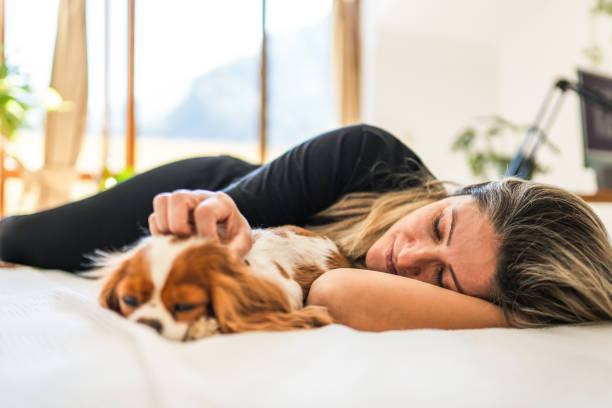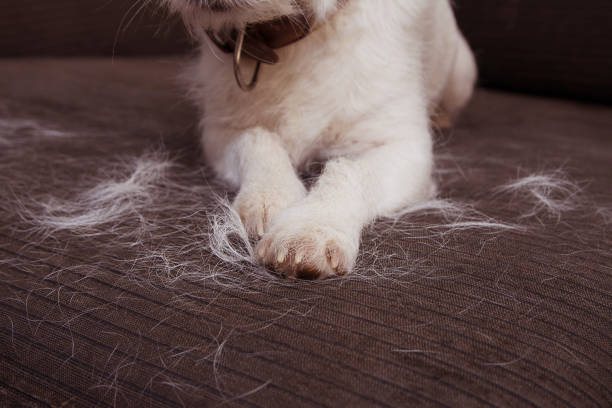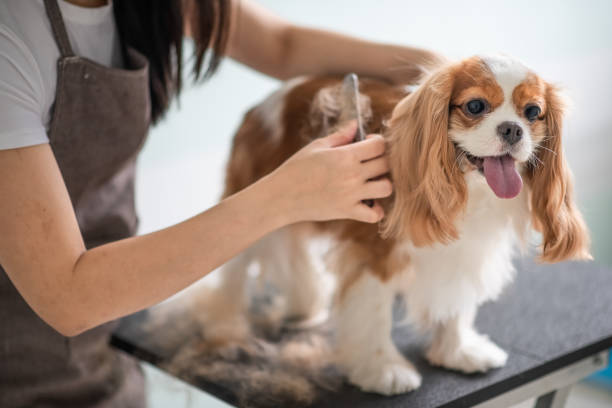Learn How To Keep Dog Hair Off Bed. If you prefer sleeping with your pets at home, you are aware of the difficulty in maintaining clean bedding. Pet hair and fur from dogs and cats can trigger allergies, spread germs and bacteria, and alter the feel of ultra-soft duvets and sheets with high thread counts.
Pets shed fur daily, which can get into your mattress and upholstery even if you don’t let them on the bed. What’s worse is that allowing the fur to accumulate allows bacteria and odour-producing materials to remain in your house.
Fortunately, it’s a simple remedy if you maintain consistency and adhere to the proper care instructions for your bedding. Here are some pointers on properly cleaning duvet covers when you have pets and preventing pet hair from getting on your bed linens.

1. COVER YOUR BED WITH A BLANKET OR QUILT.
When your pet’s hair bothers you, think about covering your bedding with a fleece blanket or an embroidered quilt. Most of your pet’s fur will gather on these, not your plush comforter or duvet cover, adding an added layer of protection.
Unlike comforters and duvet covers, blankets and quilts are significantly easier to launder and can add colour and personality to your bedroom. Keep this top layer to safeguard the remainder of the bedding if your pet enjoys taking naps on your bed during the day.
You might also choose a dark one so the fur won’t be as obvious!
2. Pick the appropriate material and thread count.
Pets respond better to certain fabrics and bedding materials than others. While some fabrics will draw dust and hair, others appear dog-hair-proof fabrics. Which duvet cover is ideal for dog hair? The best pet hair-resistant bedding is machine washable and has a high thread count for durability and quick washing.
Pet co-sleepers, for instance, typically do better with cotton sateen bedding than with jersey or nylon materials, which tend to collect hair and fur that can be challenging to remove. It’s also preferable to prevent pet hair because it sticks to wool. The cheap cloth will not hold up well even after thorough washings.
3. KEEP EXTRA SHEETS AVAILABLE
Having a couple of extra sheets on hand at all times is another excellent strategy to keep your bedding clean. You can use them while your existing set is being washed or if an accident necessitates a rapid change of linens.
To ensure that you and your pet can always have a good night’s sleep, make sure all your bedding selections are snug and comfortable. If your sheets are of comparable quality, it will also be simpler to switch out sets. If the new sheets are less comfortable, you might be less likely to wash and change your bedding, leading to increased pet fur and bacteria accumulation.
4. CONSISTENTLY AND REGULARLY WASH YOUR BEDDING
You may need to increase your cleaning routine if you want to avoid replacing your current bedding with fabric that will attract less hair to maintain your bed fresh and clean. If you have pets, follow these instructions for washing your bedding properly:
The cover should be kept apart from your duvet insert and other objects that cannot be washed in a washing machine.
Throw your bedding in the dryer first and use the air or no-heat cycle to maximize your wash and eliminate any remaining scents and fur. The hair is made free by the tumble motion and is then drawn into the dryer’s lint filter.
As soon as possible, clear the clogged lint trap and take everything accumulated from your bedding. By doing this, contaminants won’t be redeposited on the other items you’re washing; cleaning the lint trap will also improve airflow and prevent odour accumulation.
Then, to prevent cross-contamination, wash fur-covered bedding separately from other items and upholstery.
To keep your duvet cover in good condition, carefully follow the care recommendations while washing it.

5. CLEAN YOUR BEDDING.
To keep your bedding clean in between washes, vacuum it. Use the vacuum cleaner’s brush attachment to go over your sheets. To achieve optimal suction, empty the vacuum bag or dust cup after each session.
Try wiping your bedding and removing any last bits of pet hair with a clean, wet sponge after thoroughly vacuuming before making your bed.
6. USE A LINT ROLLER OR BRUSH.
Use a sticky lint roller or clothing brush to remove stray hairs and fur to keep your bedding clean between washes. Before using your lint roller or brush to clean it properly, you can apply an anti-static spray to remove any remaining hair.
Packing tape should be wrapped around your hand with the adhesive side facing outwards if you don’t have a clothes brush or lint roller. To get rid of stray hairs, pat the tape over your bedding well. You can also use a microfiber cloth or a cellulose sponge for extra fur on your bedding. Use rubber gloves when cooking.
7.USING RUBBER DISHWASHING GLOVES.
Use rubber gloves in the kitchen.
Using rubber dishwashing gloves is another useful trick to get rid of pet hair. For cleaner lines, adhere to the following steps:
Put the rubber gloves on your hands and gently wipe your bedding with them.
You will create static when you rub the gloves across the fabric, which can attract stray hairs.
Before using them on your linens, you can briefly dampen the gloves with water. Compared to dry gloves, this might draw in more hair.
Rinse the gloves after they are completely covered in fur, then repeat.
Every few days, use this tip to keep your bedding cleaned longer and prevent the need for as many washings. The fabric may deteriorate quickly if you wash your sheets and duvet cover too frequently.
8. REGULARLY BATHE AND BRUSH YOUR PET.
You must also clean your pet; don’t simply concentrate on your bedding! Bath your furry pals regularly to get rid of the filth that collects on their bodies during the day, as advised by your veterinarian for the breed of your pet. Regular bathing removes dead skin and hair, reducing shedding and maintaining the cleanliness and health of your pet’s coat.
To promote shedding, groom your pet weekly as often as possible. Instead of waiting for the fur to fall off your bed, you can remove loose hair in this way.
Dogs, in particular, require frequent brushing to reduce hair accumulation.
9. PURCHASE A PET BED.
While having a pet share your bed has many advantages, it has more fur and odor issues. You can cut down on your pet’s time on your bed by getting them their own and teaching them to sleep there. Doing this allows you to easily maintain your bedding clean and odor-free for a longer period as the amount of hair, fur, and filth on it will be much reduced.
10. Use bedding with prints or patterns.
This is more of a concealment tip than a cleaning tip. You can choose patterned and printed sheets if you are not sensitive to pet hair or if you don’t mind pet hair on your bed as long as it is not too obvious:
Duvet covers, quilts, and sheets
In addition to adding some color to your space, these gorgeous designs will also help cover up any pet hair on your bed.
11. Examine obedient training.
It’s best to establish some discipline even if you don’t like your pet climbing on your bed so you can maintain control, even if you don’t mind it. Teach your pet to only jump on the bed when you are home or to wait for an invitation before doing so. Doing this can prevent shedding and make the bed a wonderful gift for your pet.
Use straightforward instruction, such as “up” or “down,” and reinforce good conduct with praise. If you need help training, consider hiring a professional trainer.

12. SECURE YOUR ROOM'S DOOR.
Please get in the habit of closing your bedroom door when you don’t want your pet to sleep with you or when you want to keep them out when you go outside. This is a simple solution to stop your pet from sleeping in your bed and stop worrying about pet dander remaining on your linens.
Preventative Action Is Vital
If your dog sheds a lot of hair on your bed every night, you may need to increase the frequency of brushing sessions. Any hair you brush off won’t land on your bed because it was removed.
Some dogs can require more frequent brushing at particular times. Most dogs that shed frequently go through phases where they “blow their coat.” In other words, individuals start losing more hair than usual. Although the shedding itself is linked to hormones rather than the actual seasons, this typically occurs whenever the seasons start to change.
Compared to fixed dogs, unfixed dogs tend to shed more during these times. This is because they have more fluctuating hormones than fixed dogs. They will start to shed more when their hormones swing too far one way. While this is normal and good for breeding dogs, it might be optional for companion animals.
If a result, you should brush your pet more frequently at certain times to maintain your bed mainly free of pet hair; prepare to modify your routine as you notice more hair on your bed and other areas of your home.
Consider hiring a professional groomer if your pet is hairy. When their coat is blowing, they can groom your dog and, if necessary, trim them.
There are numerous breeds that you should not cut, of course. Just because your dog has a lot of hair doesn’t mean you have to cut it all off. Some dogs require it to regulate their body temperature. Without it, individuals can be more susceptible to hypothermia or hyperthermia since they won’t be able to control their body temperature properly.
Which Method Should You Use to Remove Dog Hair from Your Bed?
You can use eight techniques to get rid of hair from your bed. The technique you opt for mostly relies on what you already have on hand and which works best on your dog’s hair. Because some dogs’ coats differ, some hair removal techniques are more effective than others.
We advise investing the time to experiment to determine the most effective for you. There is little of an excuse not to test out a few of these ways and decide which one you like since many of them are incredibly cheap.
